Beef in Lazio Pasta Museum in Rome
Rome's new museum dedicated to cooking
(Prototype credit:
Ronan O'Connell
)
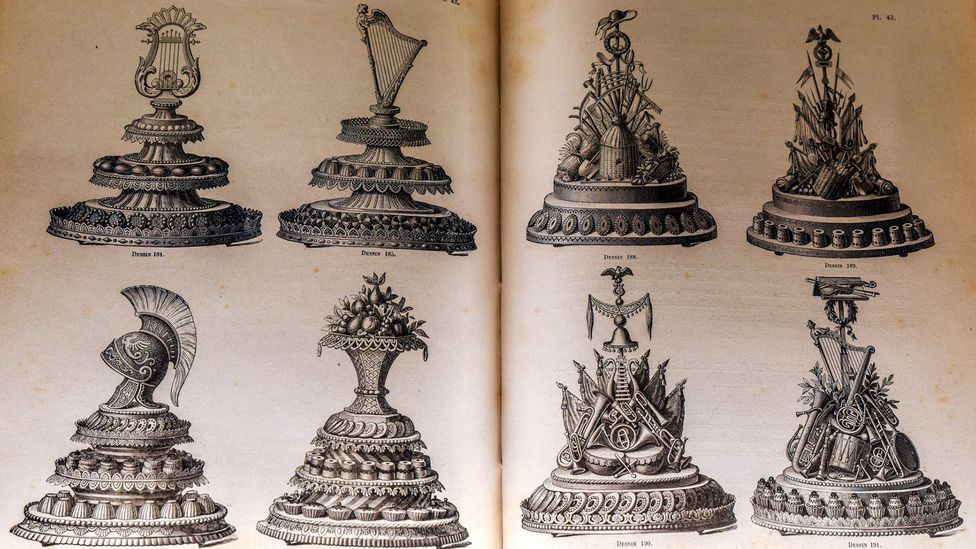
Renaissance-era ice cream moulds, 500-yr-old cookbooks, recipes meant merely for popes: Rome's newest museum is a fascinating homage to Italian republic's history of food and cooking.
F
From the outside, the museum on Palatine Hill looked like simply another of Rome's elegant palazzi, its entrance graced with statues of Roman soldiers and decorative urns.
Within, however, it was articulate that this wasn't your run-of-the-manufactory Roman mansion. Hundreds of culinary tools were displayed in glass cabinets: bulky 19th-Century pasta machines, 220-year-old Italian bowls once used by Italian monks and well-worn steel pots designed for making osso bucco, the classic northern Italian veal recipe. What at first looked similar medieval plates of armour were in fact metal tray moulds upwardly to 500 years erstwhile. Some were for baking, others for making chocolate or ice cream.
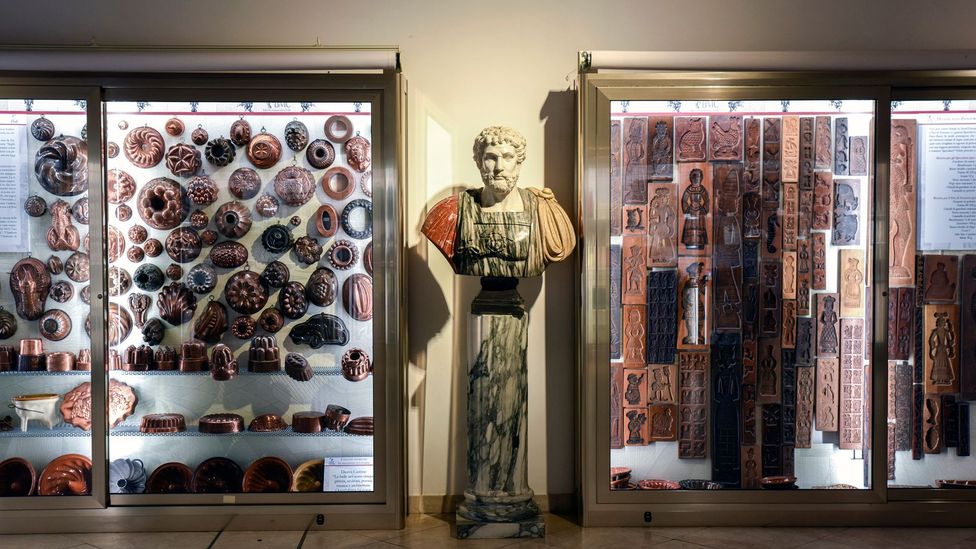
The Museo della Cucina displays instruments used for haute cuisine, pastries, chocolate, ice foam and baking (Credit: Ronan O'Connell)
Other displays held books. I stopped in front end of i illustration to expect at lumps of meat cooked over an open flame on a 16th-Century rotisserie; in the motion picture next to it, Italian men sabbatum at a feast tabular array, eating. These sketches decorate the cover of i of the oldest cookbooks displayed in the museum, Il Trinciante, written in 1593 past Vincenzo Cervio. The author was a trinciante, or carver, for Italian Cardinal Alessandro Farnese. Cervio's 74-chapter opus reveals how to precisely cut fish, pies, fruits and vegetables and, above all, meat and fowl like pork, chicken, turkey, pheasant and peacock. Detailed drawings specify Cervio's preferred etching points to ensure juicy and flavourful cuts.
Il Trinciante is i of 120 cookbooks at the Museo della Cucina, a museum opening in May 2022 that volition be the city's first focusing on the history of nutrient and cooking. Since the offset mass-printed cookbook was published well-nigh 550 years agone, many Italian recipes have been all just lost, hibernating in erstwhile texts hidden in repositories, said the museum's director, Matteo Ghirighini. The Museo della Cucina aims to rectify that. Its collection is based on that of Italian chef Rosso Boscolo and includes many of the oldest and rarest cookbooks in beingness – including some originally meant only for popes. Boscolo'southward Tuscan cooking school Campus Etoile Academy, meanwhile, will assist the museum grow rare ingredients and perfect neglected recipes once reserved only for royalty.
When I got a sneak peek at the museum in Nov 2021, it was preparing for its launch. I came across it by accident. Rome is so brimful with extraordinary sites that it's easy to overlook awe-inspiring churches and remains of 2,000-year-quondam palaces, let alone a still-to-open up cooking museum.
But already the Museo della Cucina had been included on Google Maps. And every bit I used my telephone'south GPS, I noticed its listing. What initially piqued my interest was its remarkable location. The museum is wedged between two of Rome's most important celebrated sites – the 2,600-yr-old stadium Circus Maximus, and Palatine Hill, where Rome was founded and which is cloaked in the remains of ancient palaces and temples.
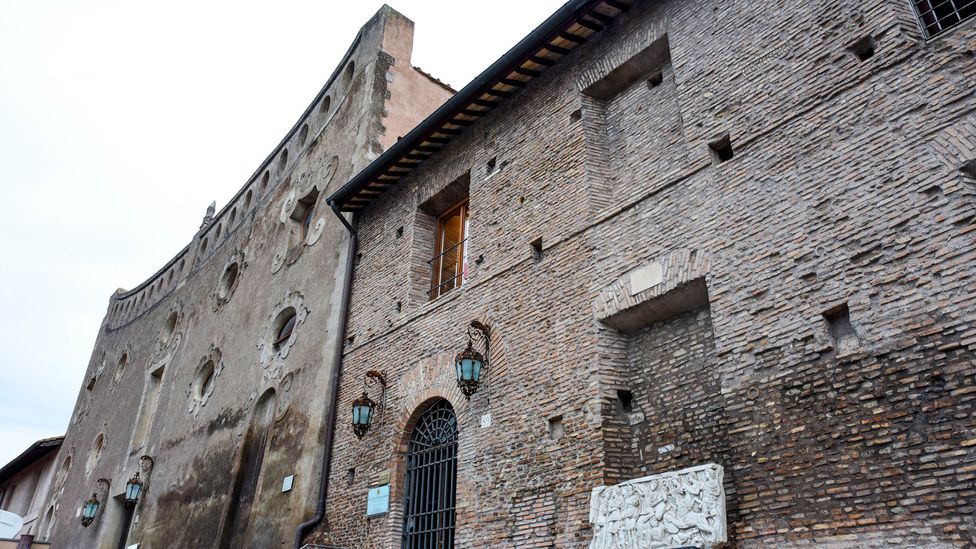
The Museo della Cucina is tucked betwixt the Circus Maximus and Palatine Colina (Credit: Ronan O'Connell)
As it turns out, the museum isn't but on the Palatine but on the specific location where Romulus and Remus, the legendary founders of Rome, were breastfed by the Roman wolf goddess Lupa more than ii,700 years ago. Myth has it that Romulus later established Rome on the same spot.
You may also exist interested in:
• The erotic design of Italian pastries
• What did the ancient Romans eat?
• Italy's beloved three-ingredient pasta dish
It is plumbing fixtures the museum sits on such a celebrated location, said Ghirighini. "Cooking as a way of reading contemporary history has often been underrated," he said. "Cooking is a production of its time and information technology tin tell us a lot nigh customs, ways of thinking, specific economic and political situations. So, a cookbook is oftentimes much more than it seems."
These sentiments were shared by Laila Tentoni, president of Italy'south renowned Casa Artusi centre for gastronomy in Forlimpopoli, northern Italy. She said Italy's food revealed an enormous amount about the country'due south passions. And cookbooks, in plow, had greatly shaped the history and management of Italian cuisine.
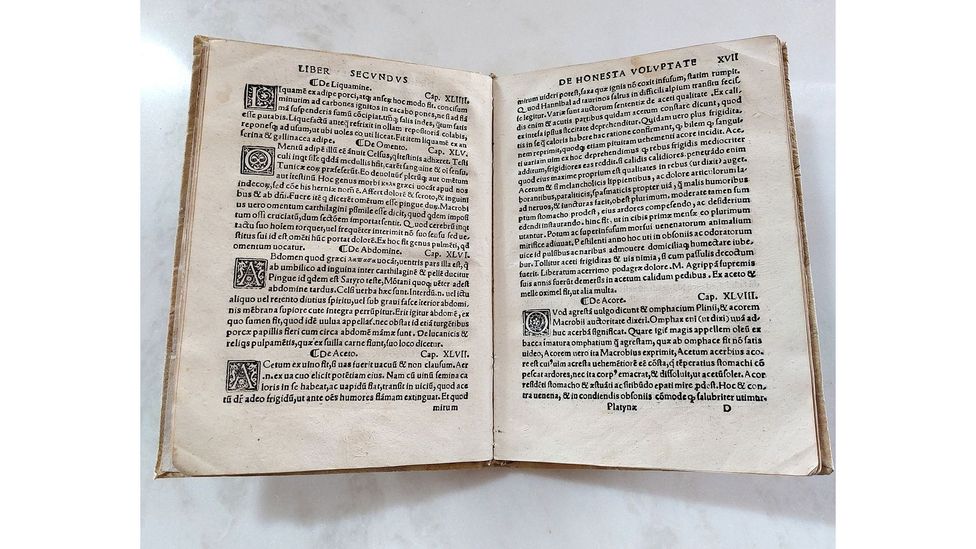
The museum displays the oldest mass-printed cookbook, Platina's On Honourable Pleasance and Health (Credit: Museo della Cucina)
Casa Artusi is dedicated to one of the country's most revered cookbook authors, Pellegrino Artusi. Tentoni said Artusi's 1891 book, Science in the Kitchen and the Fine art of Eating Well, aimed to demystify Italian cuisine that had previously been reserved for the land's elite.
"Artusi was like the first nutrient blogger," Tentoni said. "Artusi suggests to be simple, to utilise local, seasonal and quality products. Always yous must cull the finest ingredients as your raw materials, for these volition brand you polish, Artusi wrote."
I admired a rare first edition of Artusi's influential text on the second floor of the Museo della Cucina. While Artusi's cookbook is non as vibrantly illustrated as some others, it makes up for that with his colourful writing mode. "Many people will read this recipe and weep out: 'Oh what a ridiculous pasta!'," he wrote nigh his curious Lentin Spaghetti, in an English language language version of his publication I read online. Made from ground walnuts, breadcrumbs, confectioner'southward saccharide and allspice – besides known as Jamaican pepper or pimento – this sugariness spaghetti was unfailingly popular with children, Artusi said.
Some of Artusi'south recipes have since fallen out of favour – such as his recipe for eel pie. Not only is that long, slender fish difficult to prepare and melt – so much and so that Japan has many specialist eel chefs – but Artusi's recipe pairs it with raisins, rosewater and almond milk.

Dozens of former cooking utensils are displayed at the Museo della Cucina (Credit: Ronan O'Connell)
Having long ago forgotten my high schoolhouse Italian, I was unable to decipher the open up pages of the library'south books. Merely Ghirighini told me I could eventually read each one in English language once the museum's comprehensive website is completed. "Basically, you have admission to a total virtual, illustrated, guided tour through five centuries of gastronomy," he said.
From amidst that trove he singled out several texts I should examine. In addition to Artusi's classic, there was the get-go cookbook ever mass printed, On Honourable Pleasance and Health, past Italian author Bartolomeo Platina in 1474. That text, which focused on the training of unmarried meals rather than corrupt banquets, earned a huge following in Italy before its popularity saw information technology translated into French and German.
A similarly of import cookbook, Ghirighini said, was The Opera of Bartolomeo Scappi from 1570. That was written by and named after the revered Scappi, the individual chef of Pope Pius V. This cookbook, which brims with sketches of meals being prepared in chiliad kitchens, was extraordinary considering, for the offset time, information technology gave the Italian public access to recipes previously untasted outside of the Vatican.
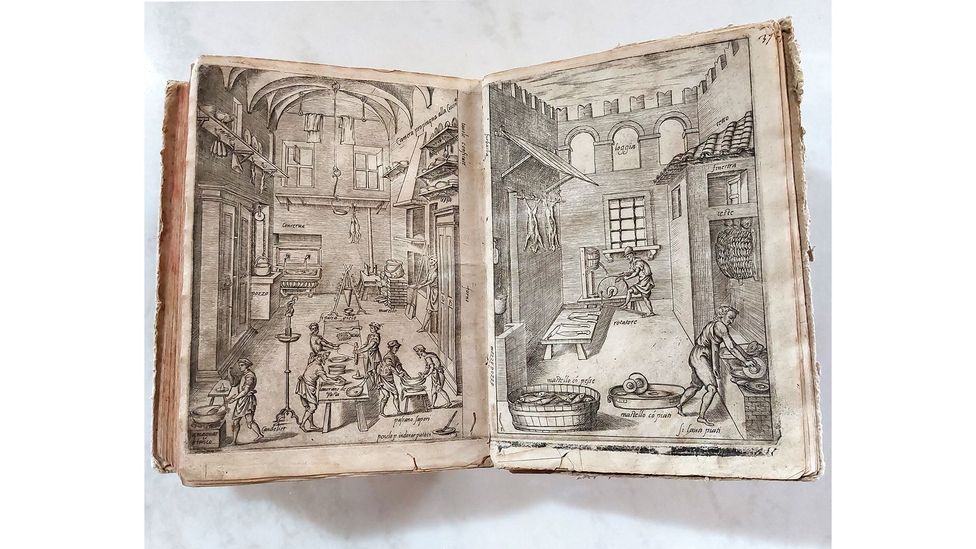
The Opera of Bartolomeo Scappi, published in 1570, was written past the private chef of Pope Pius Five (Credit: Museo della Cucina)
In particular, Scappi wrote of how Pope Pius IV was a fan of frog. Not just whatsoever frog, mind you, merely those from the city of Bologna, which were especially plump and delicious. For the Pope, Scappi would remove the frogs' surprisingly big livers, coat them in egg, flour and milk and then fry them into crispy fritters. That was a snack.
The residue of this amphibian was prepared as a heartier meal for His Holiness. Scappi would discard the caput and the tips of the frog's feet, and fry what was left only in flour. And then he'd soak information technology in verjuice sauce made from unripened grapes, which was in one case a popular ingredient amidst Italian chefs merely has largely been superseded by vinegar.
Because French cuisine had significant influences on northern Italian gastronomy – due to sharing both a border and common adoration for each other's continent-leading culinary prowess – the museum too displays many of French republic's finest cookbooks, written past the likes of Marie-Antoine Careme, Francois Massialot and Urbane Francois Dubois.
"The books in the museum comprise the first printed recipes of all the most iconic dishes of the gastronomic culture of [Italian republic and France], from lycopersicon esculentum sauce to supplì (rice croquettes) and panettone, from macarons to meringues," Ghirighini said.
As the owner of a sugariness tooth, my oral cavity watered as I admired evocative drawings of towering cakes in Careme's book Le Patissier Imperial Parisien. He pioneered a grandiose arroyo to cooking that leaned on spectacle as much as technique. From pastry, sugar and marzipan, Careme created giant replicas of famous buildings.

The museum exhibits an array of pudding moulds dating back to the 1700s (Credit: Ronan O'Connell)
Aside from books and artefacts, Ghirighini said the museum plans to bring historical dishes live with tastings, such as the kickoff-always recipe for Italian tomato sauce, from the late 1600s. Taken from Antonio Latini'south 1692 cookbook, this recipe has more in common with spicy salsa than the mild tomato sauce of the modern day thanks to its generous helping of fresh chillies.
There volition also exist on-site banquets featuring ancient recipes from the museum's cookbooks, some of which have been fallow for generations, although Ghirighini did not yet want to reveal however what they may be.
"A cookbook and nutrient museum in Rome is absolutely something new," said Flaminia Belloni, a Rome tour guide for 20 years. "It'due south a good chance to larn how the nutrient and the cooking traditions were a existent part of the lifestyle and country of mind for all Italians."
Ghirighini hopes others will concur. Later all, few feats could be more than hard than attempting to crystallise, inside one building, more than 500 years of Italian cooking – and doing justice to 1 of the most globally renowned, and fascinating, aspects of Italian civilization.
---
Join more than three million BBC Travel fans by liking usa on Facebook , or follow us on Twitter and Instagram .
If you liked this story, sign up for the weekly bbc.com features newsletter chosen "The Essential List". A handpicked selection of stories from BBC Future, Civilisation, Worklife and Travel, delivered to your inbox every Friday.
Source: https://www.bbc.com/travel/article/20220307-romes-new-museum-dedicated-to-cooking
0 Response to "Beef in Lazio Pasta Museum in Rome"
Post a Comment